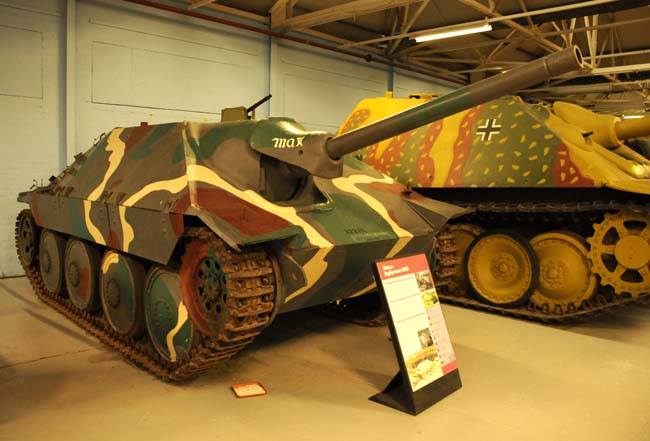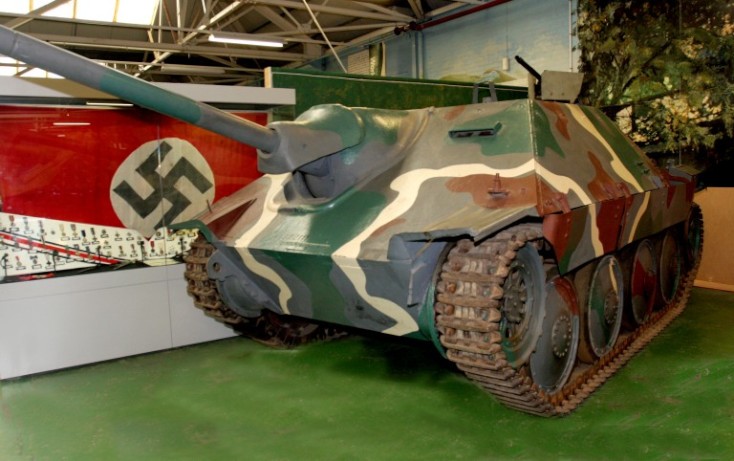
Before the Second World War Czechoslovakia had a thriving defence industry with two firms producing tanks; BMM and Skoda. Both enjoyed some export success but BMM definitely had the edge with a good light tank design. When Germany occupied Czechoslovakia their production facilities and their tanks were absorbed into the Third Reich.
Most of their products, at least up to 1943, were fairly basic conversions of tanks into self-propelled guns but with the appearance of the Hetzer in 1944 German engineers came up with a much more original design. They developed a low-profile tank destroyer based upon an order from General Guderian, which mounted an effective 75mm anti-tank gun and had good armour protection for its size.
Hetzers first entered service in the summer of 1944. They were often used in ambush situations and tended to work in groups. They proved to be fast and reliable but hard riding and cramped for the crews. One unusual feature was the remote control machine-gun mounting on top of the vehicle which was provided for close-in defence. A version of Hetzer, known as the G13, served with the Swiss Army after the war but our exhibit is an original German vehicle.
Precise Name: Jagdpanzer 38(t) Hetzer
Other Names: Gerat 555, Pz Jag Wg 638/10, Pz Jag 38(t), Panzerjager 38(t) fur 7.5cm PaK39
DESCRIPTION
The Hetzer was designed in 1943 as a small, agile, tank destroyer or Jagdpanzer. In English Hetzer means ‘baiter’, as in ‘bear baiter’.
A Jagdpanzer (literally a ‘hunting tank’) is a turretless tank. Early Jagdpanzers had open topped hulls, later ones like the Hetzer and the Jagdpanther, (see E1951.24), were fully enclosed. The main gun is carried in a limited traverse mounting in the front of the hull and is traversed over large angles by slewing the whole vehicle on its’ tracks. The main advantages of the Jagdpanzer configuration are:
– lower first cost and quicker manufacture (turrets are very expensive and complex)
– not having a turret saves weight, allowing a larger gun and/or thicker armour to be carried
– a lower profile than a tank making the vehicle easier to hide
The main drawback is the lack of tactical flexibility inherent in having to move the whole vehicle to aim the gun; this is important in offensive operations.
It is worth noting that the German Army distinguished between Jagdpanzer and Sturmgeschutze, (Assault Guns). The former were dedicated anti-tank weapons, the latter were mobile, armoured infantry support guns operated by the artillery branch.
Colonel General Guderian, the Inspector of Tank Troops, stated the requirements that lead to the Hetzer in March 1943. He wanted a small agile vehicle adequately armoured with overhead protection for the crew and a low silhouette. It was to carry a 7.5cm anti-tank gun, the Pak39. The new vehicle was to replace a number of different types of self propelled guns mounted on obsolescent tank chassis and towed anti-tank guns.
The design was based on the Czech 38(t) light tank, produced in relatively large numbers for the German Army between 1939 and 1942. This tank was originally developed by the Czech BMM Company as the TNHP for the Czecho-Slovak Army before World War II and taken over by the Germans when Czecho-Slovakia was annexed in March 1939.
The suspension and power train of the 38(t) were married to a new hull. The suspension used four large wheels on each side mounted on leaf springs. The armour plates were sloped to deflect enemy fire and were welded. The front plate sloped at 60 degrees and was 6.0cms thick. It could be pierced by many contemporary Allied tank and anti-tank guns, including the British 6pdr and 17pdr.
The 7.5cm Pak39 was mounted in the front of the hull. This was a powerful gun that fired a 4.1kg round at 990 metres/sec. It could penetrate 97mm of steel armour sloping at 30 degrees at 1,000 metres range. Virtually all Allied tanks were vulnerable to its’ fire at ranges below 1,000 metres. One unusual feature was the provision of a remotely controlled external machine gun, mounted on the top of the hull. Its’ purpose was close defence against infantry anti-tank teams.

Driven by a rear mounted Praga petrol engine the Hetzer had a top speed on roads of about 40km/hr. It was fairly agile, although its’ narrow tracks were a disadvantage in deep mud or snow. Its’ low silhouette made it easy to hide. The small hull made the fighting compartment cramped and the suspension gave the crew a fairly hard ride. The Hetzer proved to be reliable in combat.
The BMM plant started producing the Hetzer in April 1944. The Skoda plant also started building them in September 1944. By the end of the war in May 1945 2,584had been made. The Germans hoped to increase output to 1,000 a month.
Production continued after the war and 158 were supplied to the Swiss Army as the G13 in 1946. Some of these continued in service until the 1970s. Others served with the post war Czecho-Slovak Army. The Tank Museum’s example is a genuine German Army vehicle, not a post-war one.
Hetzers were converted into armoured recovery vehicles (the Bergepanzer 38(t) Hetzer) and flame-throwers (the Flammpanzer 38(t) Hetzer). It was intended to replace the conventional recoiling mounting of the Pak39 with a rigid one. This had various advantages – it was lighter and required a smaller opening in the front plate. Development problems prevented the revised vehicle, to be called the Jagdpanzer 38(t) Starr, entering production before the end of the war. It was intended to arm 10% of these vehicles with a 10.5cm assault howitzer.
The Hetzer entered service in July 1944 with the 731st and 743rd Panzerjagerabteilungen. It was issued to many German Army and Waffen SS formations and fought on both the Eastern and Western fronts. They were often used in groups to ambush enemy armoured forces.
The Hetzer was an ingenious and effective solution to the need for a tank destroyer that could be produced in large numbers. Apparently seven Hetzers could be built using the raw materials and man power needed to make one Jagdtiger (see E1952.34). The Hetzer was small, easily concealed, available in some numbers and packed a powerful punch. These characteristics were particularly useful in the sort of defensive fighting that the German Army was engaged in during the last year of the war.
VEHICLES FEATURES
Article by the Tank Museum, Bovington and there are many ways you can support them see here for more details www.TankMuseum.org
A message from the Tank Museum:
“Please Support Us: As a charity, we rely on public support for all our activities. Our work is funded entirely by people like you. With your support, we can continue to create content. With the right support we might be able to do it more regularly – and can be even more ambitious. Please Click on the Banner Below”
